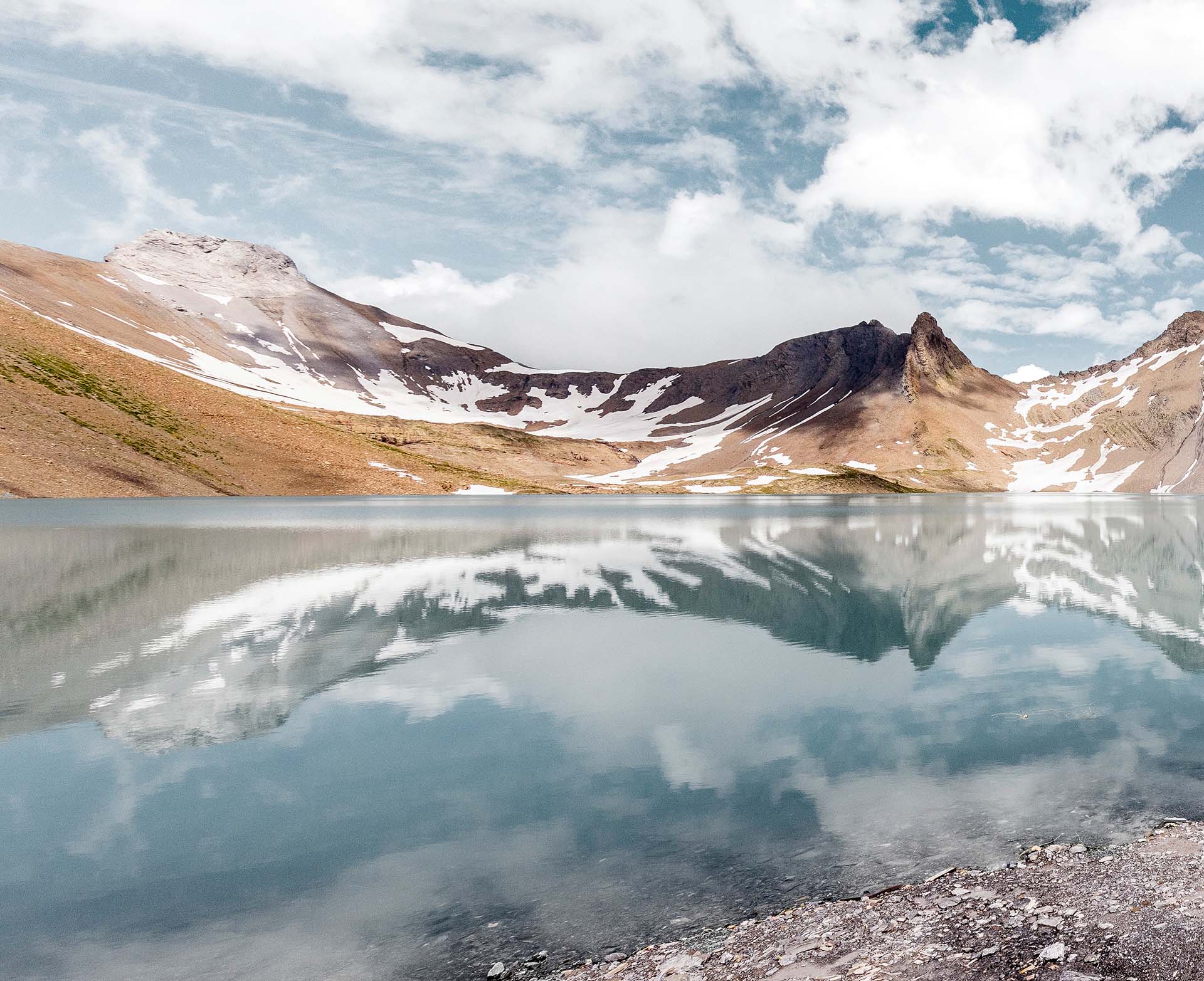25.07.2025 | Tour de Suisse of hydropower: Ecological compensation measures at the Beznau hydropower plant
Where deer will swim across the Aare in future
The re-licensing of the Beznau hydroelectric power plant involves six ecological replacement and compensation measures. In addition to a protected waiting area and safe access for wild animals to cross the river, Axpo is creating new spawning and nesting sites at various locations. The renaturation measures are exemplary and create new habitats in the lower Aare valley.
Wearing a safety vest and helmet, Livia Wyss leans against a parked excavator and takes photos with her mobile phone. She regularly checks the progress of the replacement and compensation measures being implemented upstream of the Beznau hydroelectric power plant on both sides of the Aare river at the six construction sites. ‘I like being right there on site,’ Livia Wyss admits candidly. ‘It's a great feeling to see plans gradually becoming reality.’ The 30-year-old environmental engineer is not only responsible for environmental impact reporting at Axpo, but also for environmental construction monitoring. Together with colleagues from the engineering construction department, power plant operations and asset management in the Hydro Power & Biomass Division, she is responsible for implementing the measures.
In 2023, the canton of Aargau granted the Beznau hydraulic power plant a licence for a further 30 years of electricity production. The licence was accompanied by six ecological replacement and compensation measures. Livia Wyss joined the existing project team to implement these measures. She had previously completed her apprenticeship with the ecological replacement and compensation measures for the re-licensing of the Klingnau power plant on the Aare. She now knows the waters of the Lower Aare Valley like the back of her hand, even if her unadulterated Appenzell dialect betrays her other roots.
The summer of 2025 is warm and dry on most days. Perfect conditions for the crew of the local construction company. Livia Wyss has already worked with some of the experienced machine operators at the Klingnau reservoir. ‘It's a well-coordinated team that thinks for itself and is excellent at assessing the impact of our revitalisation measures under changing conditions and at different water levels,’ says the engineer.
Wildlife corridor runs through the Aare
Not far from the excavator, swarms of insects dance above a large excavated area. ‘This is exactly where a shallow lake will be created,’ says Livia Wyss, taking pictures of the groundwater pushing through the ground at its deepest point. Flanked by piles of stones and branches, the shallow lake will provide shelter for various fish, small mammals, reptiles, amphibians and insects.
Right next to it, the plans envisage a waiting area for wild animals, protected by shrubs and trees. ‘Whether deer, badgers or squirrels, wild animals should be able to rest safely before and after crossing the river.’ The wildlife waiting area was defined and planned by the canton of Aargau because a supra-regional wildlife corridor runs through the Aare at this point.
In future, the riverbank will slope gently down to the river. ‘Almost all wild animals can swim, but they need a shallow entry and exit point,’ explains Livia Wyss. Once the animals are in the water, their own weight and muscle power determine how quickly they can cross the Aare. "A squirrel is likely to be carried along by the river for a little longer than a deer. It is also likely to use the wildlife corridor much less frequently than roe deer or red deer, as squirrels do not migrate as far," says Livia Wyss with a laugh.
Beznau hydraulic power plant – the cornerstone of Axpo
Two hundred metres from the new shallow lake is the weir that diverts part of the Aare into the headrace canal. The Beznau Hydraulic Power Plant, as it is officially known, has been in operation for 123 years. Although it now stands in the shadow of the two neighbouring nuclear reactors of the same name, the hydroelectric power plant, with its output of 25 megawatts (MW), forms the historical foundation of Axpo. Together with the Löntsch storage power plant in Glarus, the first electricity grid was created in 1908, which was essentially the first electricity network of Nordostschweizerische Kraftwerke AG, as Axpo Power AG was called until 2009. Even today, the eleven turbines reliably produce electricity for around 45,000 four-person households.
River power plants such as the Beznau hydraulic power plant produce electricity around the clock. This is known as base load energy, i.e. the energy that is continuously required for everything that is on standby, for cooling and data centres, or even for traffic lights and street lighting. Base load is an important part of Switzerland's electricity supply and is simply indispensable in a largely electrified world.
New side arm – a refuge for fish during floods
Meanwhile, three kilometres upstream, Livia Wyss pulls out her mobile phone to document the current status of the work between Stilli and Villigen. Since the beginning of May, a new side arm and a collection of pools have been created on the left bank of the Aare. ‘The biotopes serve as spawning grounds for amphibians, are fed by precipitation and sometimes dry out temporarily.’ They thus ideally complement the existing permanent pond maintained by Pro Natura at this location.
With the new side arm of the Aare, Axpo is creating a new body of water several hundred metres long. Layouted in a serpentine pattern, its calm shallow water zones provide an ideal home for fish larvae and young fish. ‘The side arm also has an important protective function. Fish can retreat here during floods,’ explains Livia Wyss. Last but not least, the existing riverbank of the Aare will gain new bays and gravel islands. ‘Some of the deadwood and driftwood we have used here in the side arm comes from the hydroelectric power plant itself. Employees have been collecting it at the weir since last year.’ Water will flow through the new side arm from August. ‘It will be a beautiful moment,’ admits the environmental engineer.
New spawning grounds on the Beznau peninsula
The third focus of the ecological replacement and compensation measures concerns the residual water section of the Aare, i.e. the part of the river that is not diverted into the headrace canal. ‘Because the left bank has been known as a landslide area for decades, the bank protection must remain in place in the form of concrete slabs,’ explains Livia Wyss. ‘However, we are now upgrading this section with structures that protrude into the water. These “groynes” provide a protected space for fish and increase the diversity of the flow.’
The right bank of the residual water section is part of the Beznau peninsula. Half of the island is occupied by the nuclear power plant of the same name. Not far from the two reactors, the peninsula surprises visitors with a sandy stretch of shore that the local population likes to use as a bathing beach. ‘However, this gravel and sand bank with its floodplain forest is also an important spawning ground for grayling and nase,’ Livia Wyss points out. The riverbed has been increasingly sealed for years. As a recurring measure, Axpo now wants to loosen up the gravel bank every one to two years so that the gravel can be used again as a spawning ground. ‘We use an excavator with a special attachment for this.’
Started in May, the work is gradually taking shape. ‘Since July, we have also been able to start work in the water, as the fish conservation period in the canton of Aargau runs from November to the end of June.’ Livia Wyss and her crew intend to keep to the schedule until the end of October. ‘We are on track and excited to see how the wildlife will react to the new opportunities.’
Tour de Suisse of hydropower
This article is part of the series "Tour de Suisse of hydropower". Previously published:
- Stabilising the electricity grid with water from the valle mesolcina
- Modern Axpo Power Plant produces energy for 14’000 households
- Hydrogen from the rhine
- Hydropower goes digital
- Unassuming but essential
- The first partner power plant in Switzerland
- A refuge for birds, fish and beavers
Axpo: a leader in hydropower
Axpo currently operates 60 hydropower plants with a total turbine output of almost 4,000 MW, making it Switzerland's largest hydropower producer.
Axpo has been building and operating hydropower plants for over 100 years and therefore has immense expertise in this field.
Including its shareholdings, Axpo is responsible for 11 TWh of electricity from hydropower each year, which corresponds to almost a third of the energy produced from hydropower in Switzerland
Axpo employs around 550 people in the operation, maintenance, renewal and management of hydropower plants, 120 of whom work in hydropower-specific engineering
Thanks to its large hydroelectric power plant with over 150 machine sets (generator with turbine) and 45 dams, Axpo has many highly qualified specialists in all specific areas of hydroelectric power. This enables Axpo to master even demanding challenges in the operation and maintenance of hydroelectric power plants efficiently and cost-effectively.
Axpo was the first hydropower company in Switzerland to recognise the huge potential of digitalisation and subsequently built Switzerland's first digital hydropower plant. Axpo continues to lead the way in the development and application of digital tools for optimised hydropower plant operation.



